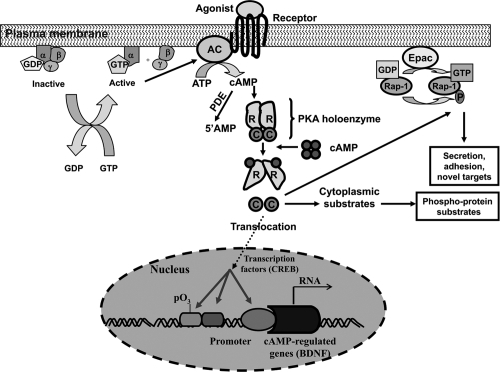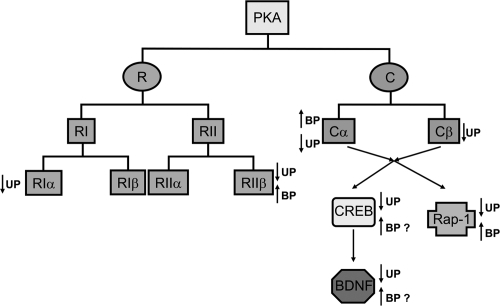Figures & data
Figure 1 Overview of the adenylyl cyclase–cyclicAMP signaling system. In this signaling pathway, the binding of agonists to receptors leads to the activation of G proteins, which in turn activate adenylyl cyclase. In the inactive state the α subunit of G protein is bound to GDP and to βγ subunits. The binding of agonists to receptors causes an interaction of receptors with G proteins, which, in turn, releases GDP in exchange with GTP. This leads to generation of α-GTP and a βγ subunits dimer. Both α and βγ subunits can interact with effectors. Activation of adenylyl cyclase causes generation of cAMP from ATP. cAMP binds to the regulatory (R) subunits of tetrameric PKA holoenzymes. The binding of cAMP to an R subunit lowers its affinity for the C subunit. This causes the release of free catalytic (C) subunits. The C subunit can catalyze reversible protein phosphorylation and irreversible phosphorylation of newly synthesized peptides. Phosphorylation of substrates can occur in the cytoplasm or, after translocation of the C subunits, in the nucleus. One of the substrates of PKA is transcription factor cyclicAMP response element binding protein CREB, which regulates transcription of many neuronally expressed genes, including brain-derived neurotrophic factor (BDNF). The exchange protein activated by cAMP (Epac) is stimulated by cAMP to exchange GDP with GTP on Rap-1. Rap can also be regulated by phosphorylation by a C subunit of PKA. Deactivation of PKA is achieved through degradation of cAMP to 5’AMP by cAMP-specific phosphodiesterases.

Figure 2 PKA catalytic (C) and regulatory (R) subunit isoforms expressed in brain and decrease (↓) or increase (↑) in expression of specific C and R subunits and of CREB and BDNF in unipolar (UP) and bipolar (BP) disorders. PKA R subunits are divided into two subtypes, RI and RII. RI and RII subtypes contain two isoforms each, ie, α and β. All four R subunit isoforms are expressed in brain. On the other hand, brain expresses α and β isoforms of C subunit. The indicated decreases and increases in PKA subunits are based on human postmortem and peripheral studies in unipolar and bipolar disorder patients. The question mark (?) indicates the possible upregulation of BDNF and CREB in bipolar disorder patients based on preclinical studies.
